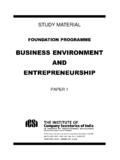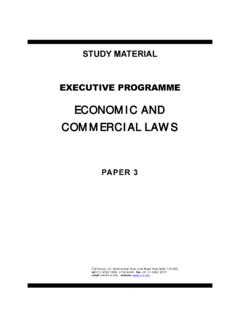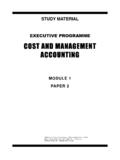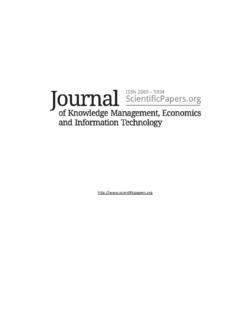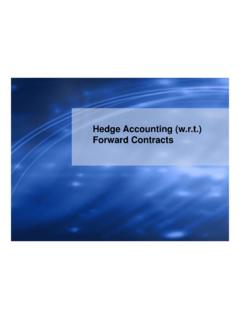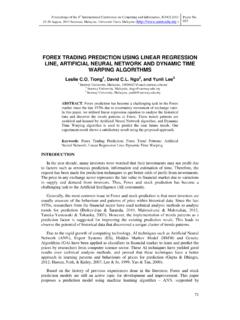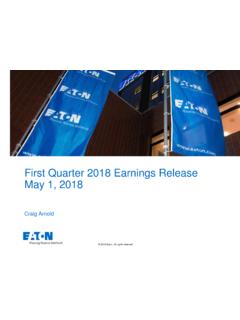Transcription of FINANCIAL, TREASURY AND FOREX MANAGEMENT
1 PROFESSIONAL PROGRAMME. financial , TREASURY AND FOREX MANAGEMENT . STUDY I. NATURE AND SCOPE OF financial MANAGEMENT . Nature, Significance and scope of financial MANAGEMENT Investment Decisions Financing Decisions Dividend Decisions Decision Criteria Objectives of financial MANAGEMENT Profit maximisation versus Shareholder Wealth Maximisation Economic Value Added Value of Firm Risk and Return Liquidity Profitability Costing and Risk financial Distress and Insolvency financial MANAGEMENT as Science or Art Functions of financial Executives financial Sector Role and Functions financial Sector Reforms in India Background financial Sector Reforms in India Philosophy and Strategy Salient Features of financial Sector Reforms in India financial Sector Reforms Present Scenario General Status of Economy financial
2 Sector Reforms Some Criticisms financial MANAGEMENT A New Look SELF-TEST QUESTIONS. STUDY II. CAPITAL BUDGETING DECISIONS. Capital Budgeting A Concept Need for Capital Investment Investment Decisions MANAGEMENT Perspective Importance of Capital Budgeting Factors Influencing Investment Decision Rationale of Capital Budgeting Decisions Kinds of Capital Budgeting Decisions 36 PP-FTFM-2. Planning of Capital Expenditure Capital Expenditure Control Capital Rationing Capital Budgeting Process Investment Criteria The Payback Method The Average Accounting Rate of Return Method Discounted Cash Flow Method Net Present Value Method Internal Rate of Return Profitability Index Comparison of Net Present Value and Internal Rate of Return Approach Points of Differences Points of Similarities Choice of Methods Sensitivity Analysis Simulation for Risk Evaluation Linear Programming and Capital Budgeting Decisions Application of Linear Programming Model Primal Dual Problems Cost of Capital and its Implications in Budgeting Decisions Capital and Cost of Capital Composite Cost of
3 Capital Implications in Budgeting Decisions SELF-TEST QUESTIONS. STUDY III. CAPITAL STRUCTURE. Meaning of Capital Structure Significance of Capital Structure Factors Influencing Capital Structure Capital Structure vis-a-vis financial Structure Planning and Designing of Capital Structure Optimal Capital Structure Determinants of Capital Structure Capital Structure and Valuation Capital Structure Theories Net Income Approach Net Operating Income Approach Modigliani Miller Approach Leverage 37 PP-FTFM-2. EBIT- EPS Analysis Cost of Capital Factors determining Cost of Capital Cost of Debt Cost of Preference Share Capital Cost of Equity Capital Cost of Dividends Cost of Retained Earnings Combined Cost of Capital Weighted Average Cost of Capital Marginal Cost of Capital SELF-TEST QUESTIONS.
4 STUDY IV. SOURCES OF FINANCE. Introduction Equity Shares Preference Shares Safeguards for the Preference Shareholders Rights Issue Debentures and Bonds Importance of Debentures Company Deposits Benefits to the Depositors Secured Premium Notes Sweat Equity Shares Tracking Stock Mortgage backed Securities GDR/FCCBs Term Loan from financial Institutions and Banks IFCI Ltd. ICICI. IIBI. SIDBI. Internal Funds as Source of Finance Dividend Policy and Retention of Profits Bonus Shares Deferred Payment Arrangements International Finance and Syndication of Loans International financial Market Syndicated Eurocurrency Loans Finance from Foreign Sources 38 PP-FTFM-2. International Finance Corporation (IFC).
5 International Bank for Reconstruction and Development (IBRD). International Development Association (IDA). International Monetary Fund (IMF). Asian Development Bank (ADB). India's Commercial Borrowings Corporate Taxation and the impact on Corporate Financing Financing Cost Escalation SELF-TEST QUESTIONS. STUDY V. DIVIDEND POLICY. Introduction Forms of Dividend Different Types of Dividend Policies Stable Dividend Policy Theory Residual Theory of Dividend Policy Relevance of Dividend Walter Formula Dividend Growth Model Irrelevance of Dividend Marginal Analysis and Residuary Theory Determinants of Dividend Policy Recommendation as a Finance Manager Legal Aspects of Dividends Transfer of Unpaid/Unclaimed Dividend to Investor Education and Protection Fund Corporate Dividend Practices in India SELF-TEST QUESTIONS.
6 STUDY IV. WORKING CAPITAL MANAGEMENT AND CONTROL. The Basic Concept Theoretical Description of Working Capital Determinants of Working Capital Current Assets and Fixed Assets Financing Operating Cycle Concept and Application of Quantitative Techniques Quantitative Techniques for Forecasting Working Capital Needs Techniques for Allocation of Working Capital Financing of Working Capital Working Capital A Policy Decision 39 PP-FTFM-2. Control of Working Capital Working Capital Leverage Techniques for Control of Working Capital Fund Flow Statements Ratio Analysis Banking Norms and Macro Aspect of Working Capital MANAGEMENT Chore Committee Report Marathe Committee Report Kannan Committee Report Cash MANAGEMENT Motives for Holding Cash Components of Cash and Bank Balances Bank Balances Nature of Bank Balances Strategy for effective Cash MANAGEMENT Inventory MANAGEMENT Extent and Quantum of Inventory MANAGEMENT Valuation of Inventory Strategy for Inventory MANAGEMENT ABC Analysis Managing the Inventory Level Receivables MANAGEMENT How do firms ensure realisations?
7 Desirable Level of receivables Other issues involved in MANAGEMENT of working capital SELF-TEST QUESTIONS. STUDY VII. SECURITY ANALYSIS AND PORTFOLIO MANAGEMENT . The Concept of Security Analysis What is Investment? What are Securities? Nature of financial System Security Analysis and Portfolio MANAGEMENT Fundamental Analysis Analysis of the Economy Industry Level Analysis Technical Analysis Pattern Created by Charts Portfolio MANAGEMENT Portfolio Analysis Risk in Investment Situation Markowitz Model Limitations of Markowitz Model 40 PP-FTFM-2. Sharpe Index Model Capital Asset Pricing Model SELF TEST QUESTIONS. STUDY VIII. financial SERVICES. Evolution Process of financial Services Industry Role of Service Sector in Economic Development The Place of financial Services Sector Evolution of financial Services Sector Anatomy of financial Services Sector Regulation and the financial Services Sector Merchant Banker Mutual Funds Venture Capital Loan Syndication Credit Rating Credit Rating Information Services of India Ltd.
8 Investment Information and Credit Rating Agency of India Ltd. Credit Analysis and Research Ltd. Fitch India Factoring Services Leases and Hire Purchase Real Estate Financing Securitization of Mortgages Depository System in India Depository System An Overview Models of Depository Benefit of Depository System SELF-TEST QUESTIONS. STUDY IX. PROJECT PLANNING AND CONTROL. Project Planning Preparation of Project Report Format of Project Report Aspects of Project Appraisal Project Appraisal under normal inflationary and deflationary conditions Project Appraisal by financial Institutions General Approach to Appraisal Technical Aspects of Project Appraisal financial Aspects of Project Appraisal 41 PP-FTFM-2.
9 Economic Aspects of Project Appraisal Commercial Aspects of Project Appraisal Managerial Aspects of Project Appraisal Environment, Energy MANAGEMENT and Ecological Aspects Social and other Related Aspects Project Evaluation Technique Loan Documentation Loans for Modernisation and Renovation Loan Syndication Bridge Loans against sanctioned loan Assistance Monitoring the Progress of Units Assisted by financial Institutions Social Cost Benefit Analysis Promoters Contribution Project Review and Control Follow up Reports and Procedures SELF-TEST QUESTIONS. STUDY X. DERIVATIVES AND COMMODITY EXCHANGES. Introduction Concept of Derivatives What are Derivatives Characteristics of Derivatives Commodity Derivatives and financial Derivatives Differences between Spot Contract and Forward Contract Problems in Case of a Forward Contract Advantages of forward Markets How to Eliminate Limitations of Forward Contracts Moving beyond forward Contracts Stock Index Futures Stock Indices in India Trading in Index Futures Trading.
10 Clearing and Settlement on Stock Exchanges Options Difference between Future and Option What is a Premium Types of Options Trading Mechanism Contract Specification Clearing and Settlement Settlement of Furture Contracts Settlement of Options Contracts Risk MANAGEMENT System Settlement of Interest rate future 42 PP-FTFM-2. Settlement of Custodial Participants Risk MANAGEMENT for interest rate future NSE Span Parallel Risk MANAGEMENT System Swaps/Properties of Swaption Commodity Market Structure of Commodity Market Leading Commodity Exchanges in India Commodity Futures Trading India Benefit to Industry from Futures Trading SELF TEST QUESTIONS. STUDY XI. TREASURY MANAGEMENT . Introduction Objectives of TREASURY MANAGEMENT Availability in Right Quantity Availability in Right Time Deployment in Right Quantity Deployment at Right Time Profiting from Availability and Deployment Functions and Scope of TREASURY MANAGEMENT Unit Level Domestic Level Function of TREASURY MANAGEMENT at International Level Relationship between TREASURY MANAGEMENT and financial MANAGEMENT Difference between financial MANAGEMENT and TREASURY MANAGEMENT TREASURY Organization Picking the right model Organization Model Dimensions Role and Responsibilities of TREASURY Manager Tools of TREASURY MANAGEMENT Internal TREASURY Control Environment for TREASURY MANAGEMENT Role of information

